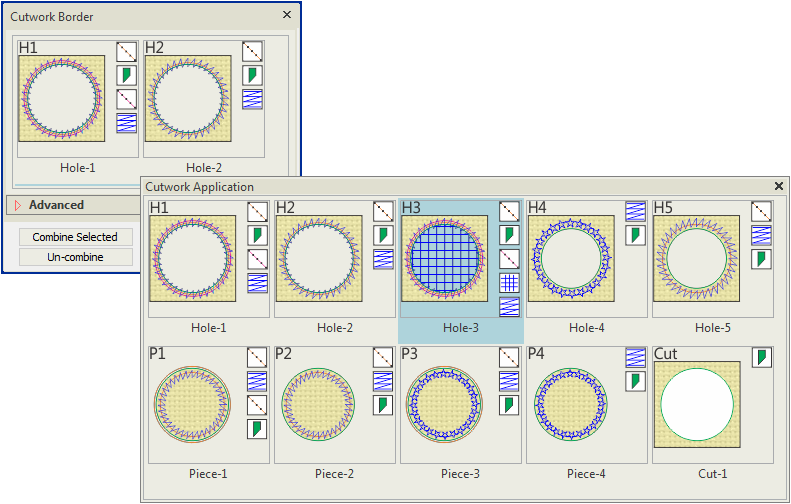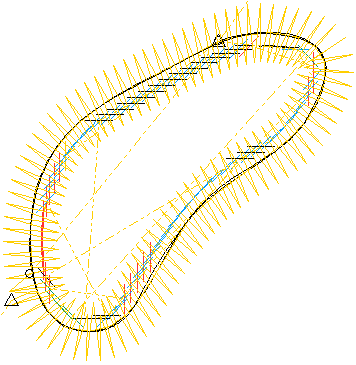Cutwork borders
Both cutwork and stumpwork designs are created with a common set of tools. Stumpwork can be made from cutwork pieces which are sewn onto the base design, usually with the addition of a wireline for extra stiffening. Both styles of embroidery make use of the Cutwork Border docker. This is organized by border type. The chosen border type determines which components are included in the cutwork / stumpwork object. The Cutwork Border docker has two aspects: the border gallery and associated settings. It can be floated as shown.
Border categories
The Cutwork Border gallery contains three categories of border...
| Category | Use |
|---|---|
| Hole | The user is primarily interested in the fabric that remains after the hole is cut. The resulting piece usually consists of some embroidery together with the cutting line. |
| Piece | The user is interested in the cut-out piece. The remainder will probably be discarded. Consists of some embroidery together with the cutting line. Piece border types are typically used for stumpwork. See also Stumpwork. |
| Cut | Open or closed cutting line without any embroidery. This can be used to create a simple cut-out piece to be sewn on as stumpwork. |
Border types
The chosen border type determines which components are included in the cutwork / stumpwork object. The border type also specifies component stitching order and spacings. For example, the simplest border produces only cutting lines. The digitized outline forms the shape the cuts follow. Alternatively, the digitized outline may form the centerline of a satin line, while the cutting line is calculated with a corresponding offset. See Border types for details.
Cutwork components
Cutwork components are generated and sequenced according to the chosen border type. Like appliqué, cutwork objects are composite, containing multiple embroidery and cutting components. They may include some or all of the following:
| Component | Use | |
|---|---|---|
Stabilizing runs | These are used to reduce deformation of the material prior to cutting or stitching. There may be several stabilizing runs in the one cutwork object. | |
| Cutting lines | As a cutting line would be unlikely to follow one of the standard cutting angles – 0°, 45°, 90° or 135° – a mix of different cutting needles is used to approximate it. The preferred mode of operation is to complete all cuts one cutting needle at a time. | |
| Tackdown runs | These are used to attach the stabilizer after a hole has been cut. Tackdowns are implemented as simple runs. They are not required for cutwork pieces. | |
Net fills | Net fills are stitched onto the stabilizer inside a cut hole. They are created after holes are cut and stabilizers tacked down. When a fill is stitched out, the edges are covered, typically, by a satin or stemstitch line. Other stitch types are available. The stabilizer is subsequently dissolved in water so only a net of stitches is left within the hole. | |
| Embroidery | Depending on the border type, embroidery may be used to cover the edge of the hole. Alternatively, it may run at a certain distance from the cutting line and stitch out before or after the material is cut. It is implemented as either satin, blanket, wireline, or stemstitch. Satin or wireline are typically used for stumpwork. See also Stumpwork. | |

